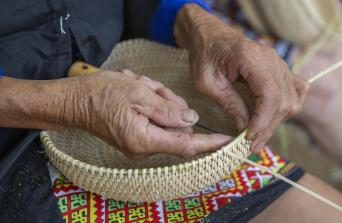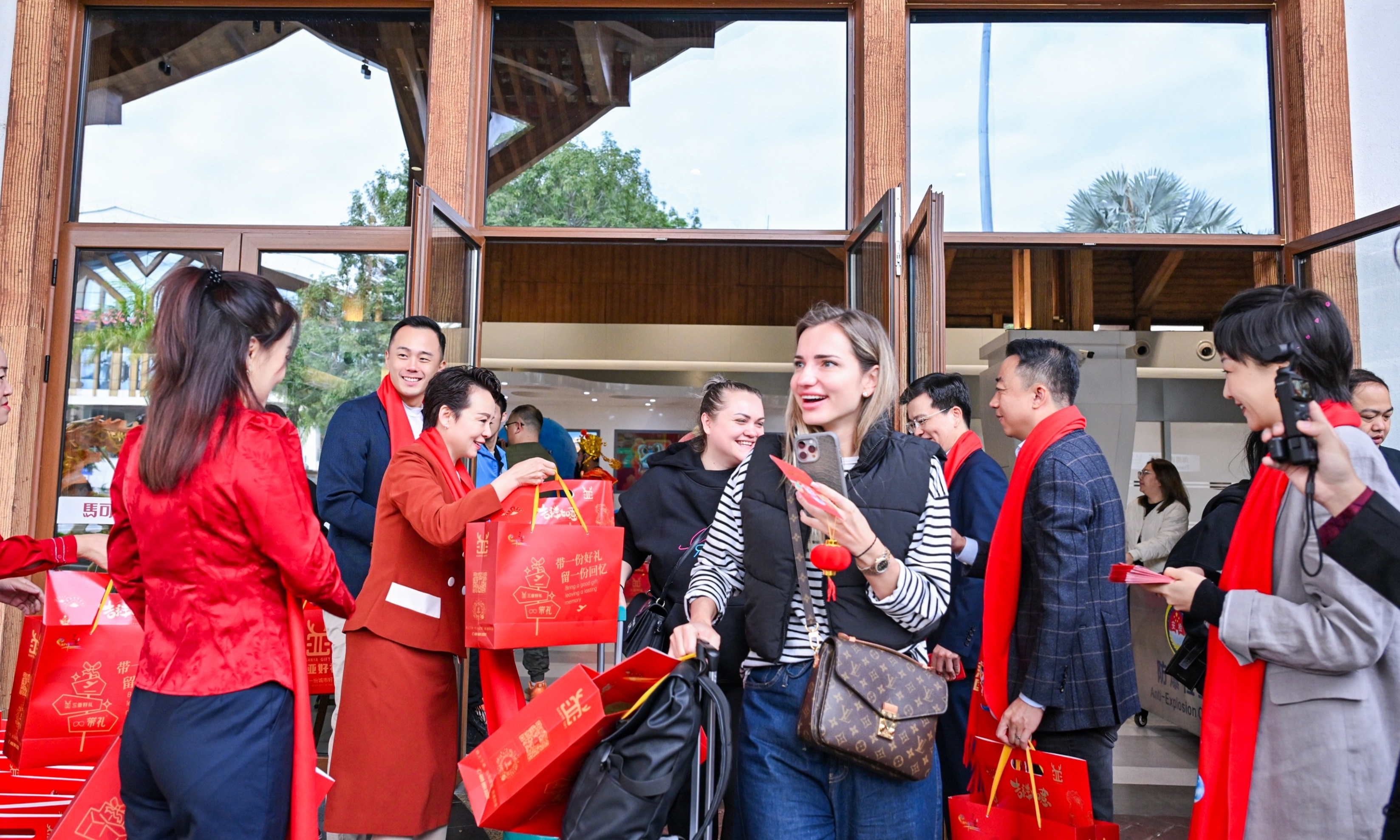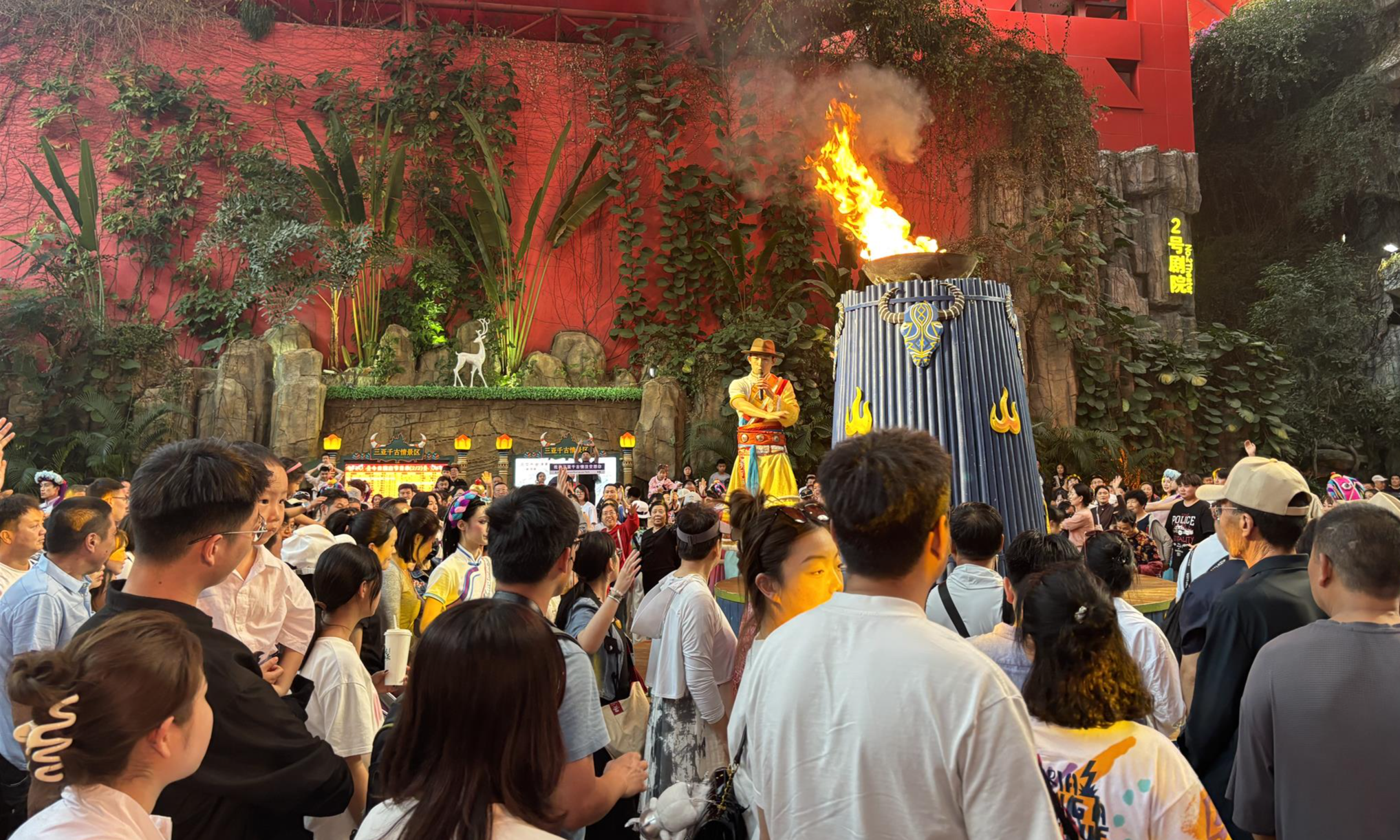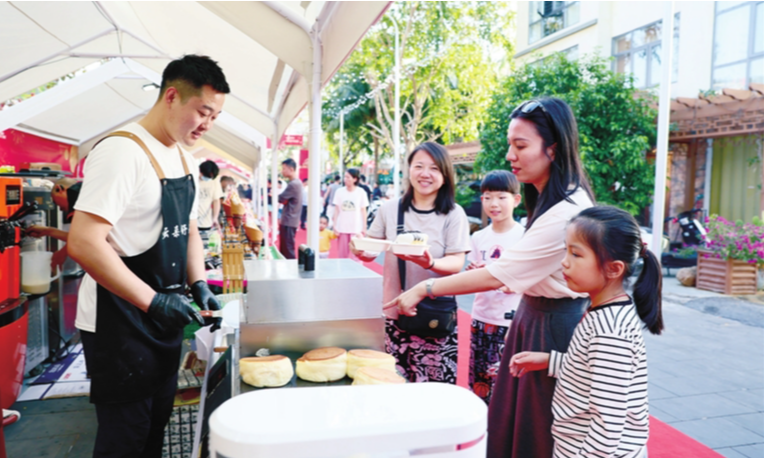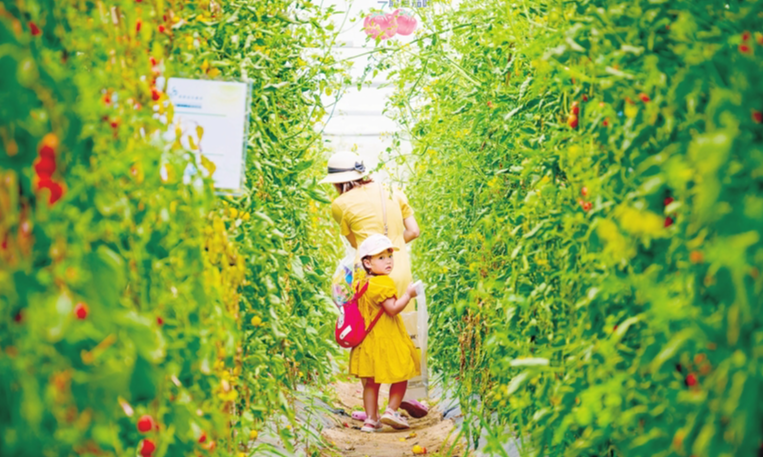看苑——中庭
Visual Pavilion —Atrium
一、落笔洞遗址简介
About the Luobidong Cave Site
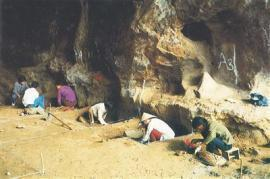
落笔洞遗址位于三亚市吉阳区落笔峰山脚下,距今10000年左右,是海南岛迄今为止已知时代最早的石器文化古人类遗址,也是我国已发现的最南端的史前人类洞穴遗址。遗址山洞属自然形成的石灰岩洞,呈不规划形,洞口朝南,洞穴高12.5m,深16m,宽9m,面积约145㎡,文化遗存丰富。在1992—1993年两次的考古发掘中,出土了晚期智人牙齿化石、石制品、哺乳动物化石等。落笔洞遗址于2001年被国务院公布为第五批全国重点文物保护单位。
Luobidong Cave Site is located at the foot of Luobifeng Mountain, Jiyang District, Sanya City. With a history of about 10,000 years, it is the earliest paleo-human site of stone culture known to date in Hainan Island, and also the southernmost cave site of prehistoric human culture discovered in China. The site is a naturally formed limestone cave with an irregular shape. With its entrance facing south, the cave, measuring 12.5 meters high, 16 meters deep and 9 meters wide, covers an area of about 145 m2. Abundant cultural remains were unearthed in the cave. During two archaeological excavations in 1992-1993, tooth fossils of late Homo sapiens, stone artifacts, and mammal fossils were unearthed. Luobidong Cave Site was announced by the State Council in 2001 as one of the fifth batch key national protected units for cultural relics.
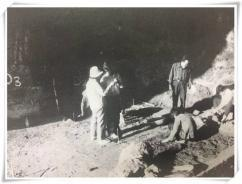
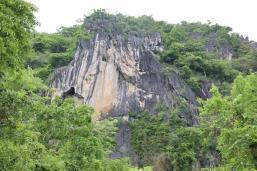
二、落笔洞文物
Cultural Relics from Luobidong Cave
(一)石制品2件
Stone artifacts - 2 pieces
1.将一椭圆形砾石从中部打断,台面以外的边缘由破裂面向背面单向加工成弧形刃,制作较为粗糙,刃缘呈粗锯齿状且较厚,器体很厚重,手握处留有岩石面。
An oval gravel was broken from the middle, and the outer edge of the table surface was processed uniaxially from the rupture surface to the back and formed a recessed curve stone blade. This roughly made blade featured thick and jagged edges, and a heavy body, with the rock surface remained where the blade was held.
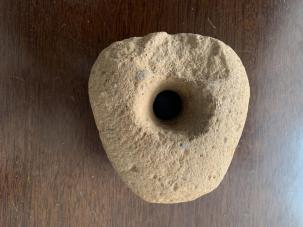
2.器体呈圆角形,器身厚重,保存完整。通体先凿打后经加磨成形,加工较粗糙,一面近平,一面稍鼓起。器身中部两面凿打钻孔并加磨,穿孔较粗。底边一端有一些使用痕迹,当为敲砸所致;器身有部分打制疤痕。
This stone artifact features a rounded, thick and intact body. The whole body was chiseled first and then ground into shape. It was roughly processed, almost flat on one side and slightly bulging on the other. The two sides of the center of the body were drilled and ground, with a thick perforation. There are some traces of use on one end of the bottom edge, which might be left by knapping; and there are also scars on the body left by chipping.
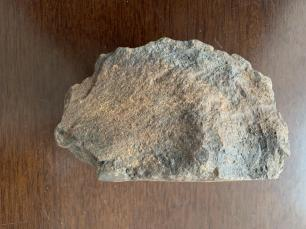
(二)骨制品2件
Bone artifacts - 2 pieces
1.用一动物长骨的碎片加工而成,保存完整。在骨片的尖端两侧进行切割、打击,加工出矛的锋部,缺乏刮磨修整;在靠近尾端处打成一个适于系住把手的扁长柄。器身很长,形状不规整,制作比较粗糙,可能是当作矛头来使用的。
This is an intact bone artifact made from a long bone fragment of an animal. The tip was shaped by cutting and striking on both sides of the top end of the bone fragment, without grinding and retouching; the long flat handle was shaped near the end. The roughly-made bone artifact, featuring a long, irregular shape, might be used as a spearhead.
2.较完整,将动物肢骨下端稍经刮磨,加工成斜弧刃,刃缘较薄,其上半部分未有加磨。
This is a well preserved bone artifact. The lower end of an animal limb bone was slightly ground and processed into an oblique arc bone blade with a thinner edge; and the upper part was not ground.
(三)脊椎动物化石6件
Vertebrate fossils - 6 pieces
1.落笔洞遗址出土的人类化石包括12颗人牙和一块左侧距骨,属智人。经碳十四检测,落笔洞遗址其年代距今约1万年左右。
Human fossils unearthed at the Luobidong Cave Site included 12 human teeth and a left talus belonging to Homo sapiens. Carbon-14 dating technique was used to determine that Luobidong Cave Site is about 10,000 years old.
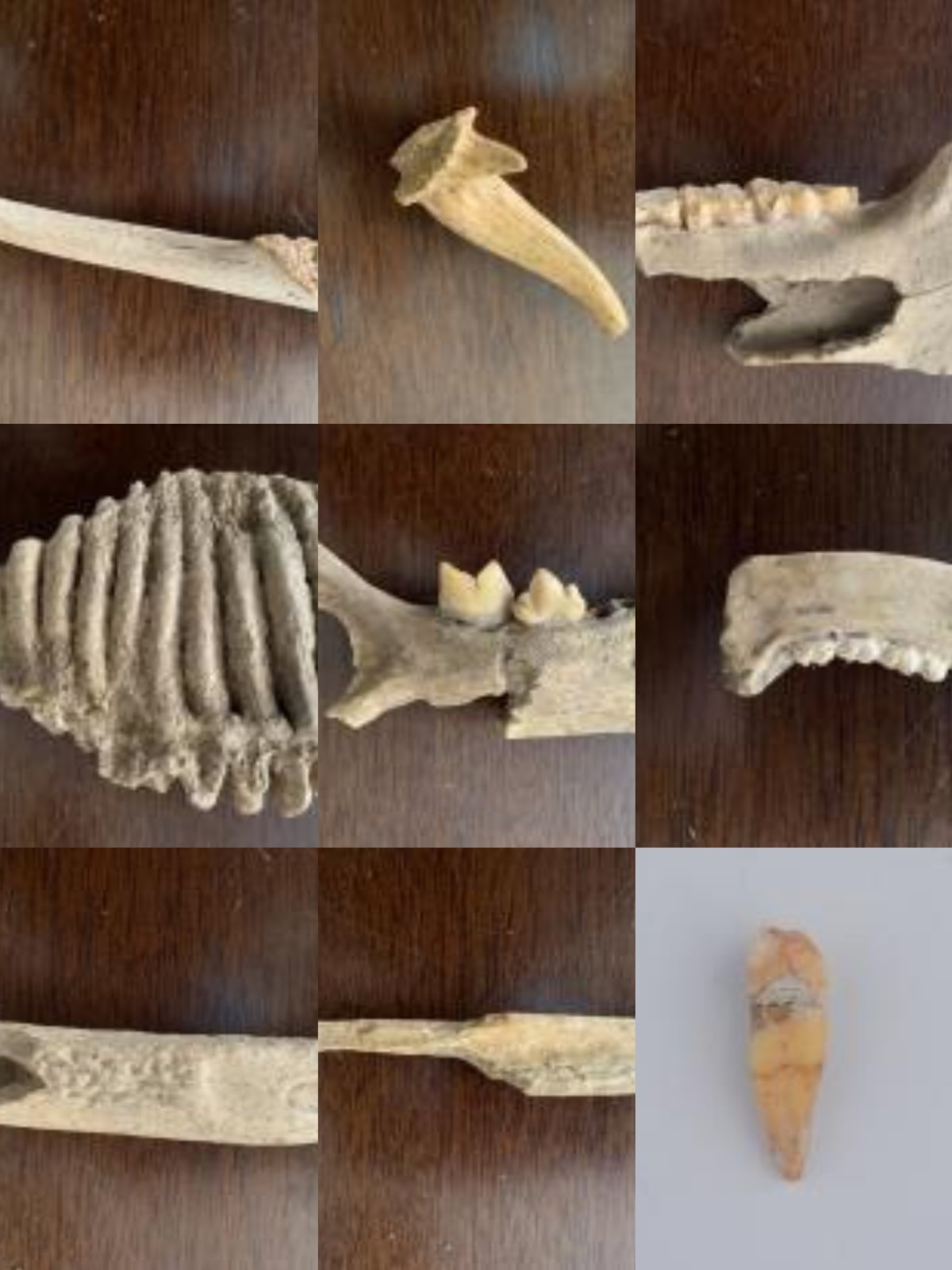
文物介绍
Descriptions
(一)石制品2件——打制石器
Stone artifacts - 2 pieces: Chipped stone tools
1. 名称:旧石器时代晚期-新石器时代早期砍砸器(复制品)
Name: Chopper from the Upper Paleolithic to Early Neolithic (Replica)
时代:旧石器时代晚期-新石器时代早期
Age: Upper Paleolithic - Early Neolithic
原料:火山岩
Raw material: Volcanic rock
2. 名称:旧石器时代晚期-新石器时代早期环状石器(复制品)
Name: Circular Stone Tool from the Upper Paleolithic to Early Neolithic (Replica)
时代:旧石器时代晚期-新石器时代早期
Age: Upper Paleolithic - Early Neolithic
原料:火山岩
Raw material: Volcanic rock
(二) 骨制品2件
Bone artifacts - 2 pieces
1. 名称:旧石器时代晚期-新石器时代早期骨矛形器(复制品)
Name: Bone Spear from the Upper Paleolithic to Early Neolithic (Replica)
时代:旧石器时代晚期-新石器时代早期
Age: Upper Paleolithic - Early Neolithic
原料:哺乳动物肢骨
Raw material: Mammalian limb bone
2. 名称:旧石器时代晚期-新石器时代早期骨铲(复制品)
Name: Bone Shovel from the Upper Paleolithic to Early Neolithic (Replica)
时代:旧石器时代晚期-新石器时代早期
Age: Upper Paleolithic - Early Neolithic
原料:哺乳动物肢骨
Raw material: Mammalian limb bone
(三)脊椎动物化石6件
Vertebrate fossils - 6 pieces
1. 名称:旧石器时代晚期-新石器时代早期黑长臂猿海南亚种下颌骨(复制品)
Name: Mandible of Hainan Black-crested Gibbon from the Upper Paleolithic to Early Neolithic (Replica)
时代:旧石器时代晚期-新石器时代早期
Age: Upper Paleolithic - Early Neolithic
分类:哺乳类 灵长目 长臂猿亚科 黑长臂猿海南亚种
Classification: Class: Mammalia; Order: Primates; Family: Hylobatidae; Species: Nomascus hainanus
2. 名称:旧石器时代晚期-新石器时代早期华南虎下颌骨(复制品)
Name: Mandible of South China Tiger from the Upper Paleolithic to Early Neolithic (Replica)
时代:旧石器时代晚期-新石器时代早期
Age: Upper Paleolithic - Early Neolithic
分类:哺乳类 食肉目 猫科 华南虎
Classification: Class: Mammalia; Order: Carnivora; Family: Felidae; Subspecies: Panthera tigris amoyensis
3. 名称:旧石器时代晚期-新石器时代早期亚洲象臼齿(复制品)
Name: Molar of Asian Elephant from the Upper Paleolithic to Early Neolithic (Replica)
时代:旧石器时代晚期-新石器时代早期
Age: Upper Paleolithic - Early Neolithic
分类:哺乳类 长鼻目 真象科 亚洲象
Classification: Class: Mammalia; Order: Proboscidea; Family: Elephantidae; Species: Elephas maximus
4. 名称:旧石器时代晚期-新石器时代早期野猪上下颌骨(复制品)
Name: Mandible and Maxilla of Wild Boar from the Upper Paleolithic to Early Neolithic (Replica)
时代:旧石器时代晚期-新石器时代早期
Age: Upper Paleolithic - Early Neolithic
分类:哺乳类 偶蹄目 猪科 野猪
Classification: Class: Mammalia; Order: Artiodactyla; Family: Suidae; Species: Sus scrofa
5. 名称:旧石器时代晚期-新石器时代早期赤麂角(复制品)
Name: Horn of Red Muntjac from the Upper Paleolithic to Early Neolithic (Replica)
时代:旧石器时代晚期-新石器时代早期
Age: Upper Paleolithic - Early Neolithic
分类:哺乳类 偶蹄目 鹿科 赤麂
Classification: Class: Mammalia; Order: Artiodactyla; Family: Cervidae; Species: Muntiacus vaginalis
6. 名称:旧石器时代晚期-新石器时代早期毛冠鹿角(复制品)
Name: Horn of Tufted Deer from the Upper Paleolithic to Early Neolithic (Replica)
时代:旧石器时代晚期-新石器时代早期
Age: Upper Paleolithic - Early Neolithic
分类:哺乳类 偶蹄目 鹿科 毛冠鹿
Classification: Class: Mammalia; Order: Artiodactyla; Family: Cervidae; Species: Elaphodus cephalophus
三、黎族钻木取火技艺
Drilling Wood for Fire of the Li Ethnic Group
钻木取火技艺是黎族先民取火的一种古老方法。该技艺主要流传于海南岛中南部黎族聚居区。
Drilling wood for fire is an ancient fire-making method practiced by ancestors of the Li ethnic group. It is mainly practiced throughout the gathering places of the Li ethnic group in the center and south of Hainan Island.

黎族钻木取火有两种方法:第一种方法为双手搓动钻火杆取火法;第二种方法为拉动弓弦转动弓木钻头取火法。
There are two methods used by the Li people to make fire by drilling wood: The first is the hand drill method of friction fire making; the other is the fire-by-friction technique known as the bowdrill, namely, pulling the bowstring to move the bow whose back-and-force movement will rotate the drill to make fire.
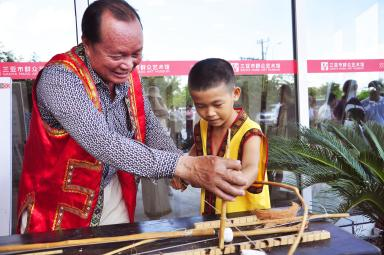
钻木取火是三亚黎族先民的重要发明,大大地促进了生产力的发展。钻木取火在三亚亮坎村得以延续和保留,为研究黎族文化发展提供了重要的实证材料。
Making fire by drilling wood was an important invention of the ancestors of the Li ethnic group in Sanya, which greatly promoted the development of productive forces. Making fire by drilling wood is continued and preserved in Liangkan Village, Sanya City, which provides important empirical materials for studying the development of the Li culture.
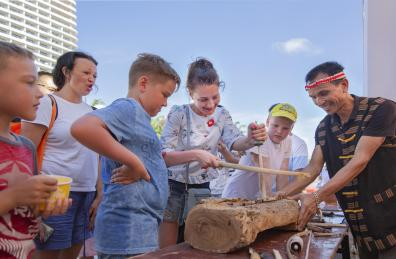
看苑——右厢房
Visual Pavilion - Right Wing
四、历史名人(屏风)
Historical Figures (Screens)
冼夫人(约518~602年)
Lady Xian (518-602)

南朝梁时,冼请命于朝,在西汉废之儋耳郡地设置崖州,恢复了海南与中央政权的直接联系,冼夫人一生维护祖国统一,促进民族团结。
During the Liang Dynasty (502-557), Lady Xian appealed to the imperial court to establish Yazhou in Dan’er County, which was abandoned in the Western Han Dynasty. This restored the direct relationship between Hainan and the central government. Lady Xian devoted her life to promoting ethnic unity and safeguarding the unification of the country.


鉴真(688——763)
Jianzhen (688-763)
鉴真,唐代高僧,是古崖州佛教文化和中原文化的重要传播者,在海南文化史上写下了堪称宝贵的一页。
Jianzhen, an eminent master of Buddhism in the Tang Dynasty, was an important disseminator of the Buddhist culture and the Central Plains culture in the ancient Yazhou, and left an incredible mark on the cultural history of Hainan.
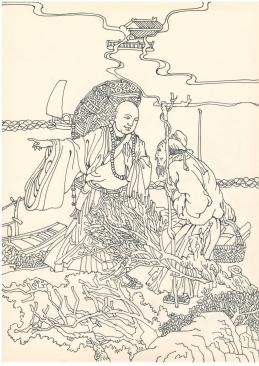
黄道婆(约1245—1330)
Huang Daopo (ca. 1245-1330)
黄道婆是中国宋末元初著名女纺织家。在崖州约40年,向当地黎族妇女学习棉纺织技艺并进行改进,总结出“错纱、配色、综线、挈花”的织造技术,并把这种先进的纺织技艺传播到中原乃至世界。
Huang Daopo was a famous female cotton weaving expert between the end of the Song Dynasty and the beginning of the Yuan Dynasty. During the four decades in Yazhou, she learned cotton weaving skills from the local Li women and improved them. She eventually proposed the pick-weaving and brocading technology, and promoted this advanced textile technology to the Central Plains and even the whole world.
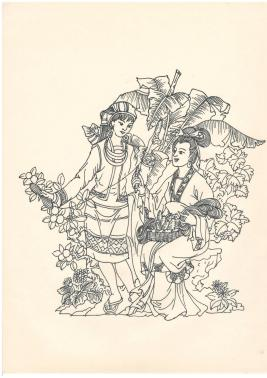
五、历史沿革(墙面)
Historical Development (Walls)
10000年前,落笔峰出现了晚期智人,他们被称为“落笔洞人”
About 10,000 years ago, late Homo sapiens appeared in the area of Luobifeng Mountain, and they were called “Luobidong Caveman”

6000年前,新石器时代古人居住在现三亚市海棠区英墩遗址一带。
About 6,000 years ago, the ancient people of the Neolithic Age lived in what is now the Yingdun site in Haitang District, Sanya City.
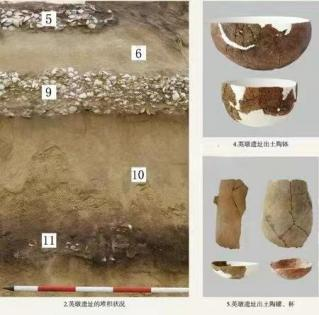
隋—设临振郡
In the Sui Dynasty (581-618), it was established as Linzhen County
唐—改为振州,后改为宁远。
In the Tang Dynasty (618-907), it was changed to Zhenzhou, and later changed to Ningyuan
汉—设珠崖郡治
In the Han Dynasty (202 B.C.-220 A.D.), it was built as Zhuya County
宋—改为崖州
In the Song Dynasty (960-1279), it was changed to Yazhou
1905年—(清光绪三十一年)升崖州为直隶州,领万安、陵水、昌化、感恩四县。
In 1905 (31st year of Guangxu), it was established as Yazhou Independent Prefecture, with jurisdiction over four counties, namely Wan’an, Lingshui, Changhua, and Gan’en
1913年—崖州改为崖县,治所仍在今崖城。
In 1913, Yazhou became Yaxian, with its seat of government in the current Yacheng Town
1950年—成立崖县人民政府。
In 1950, Yaxian People’s Government was established
1953年—中共崖县县委、县人民政府及直属机关从崖城搬到三亚。
In 1953, the Party Committee of Yaxian Country, the People’s Government and its directly affiliated organs moved from Yacheng to Sanya
1984年5月19日—国务院批准撤销崖县设立三亚市(县级),其市行政管辖区为崖县原属范围。1987年9月5日,六届全国人大22次会议通过关于设立海南省的议案。12月31日,三亚升级为地级市
On May 19, 1984, the State Council approved the abolition of Yaxian County and the establishment of Sanya City (county-level), maintaining the original administrative jurisdiction On September 5, 1987, the Sixth National People’s Congress passed a resolution at its 22nd Session to establish Hainan Province. On December 31, Sanya was officially established as a prefecture-level city.
2010年1月4日—国务院发布《国务院关于推进海南国际旅游岛建设发展若干意见》,三亚迎来跨越式发展。
On January 4, 2010, the State Council issued “Several Opinions on Promoting the Development of Building an International Tourism Island in Hainan”, which led to the leapfrog development of Sanya.
2015年 1月2日—三亚市“撤镇设区”,行政管理体制进一步完善。
On January 2, 2015, Sanya City changed towns to districts, further improving its government administration system.
2018年4月13日—习近平总书记在庆祝海南建省办经济特区30周年成立大会上,提出支持海南逐步探索稳步推进中国特色自由贸易港建设。
On April 13, 2018, General Secretary Xi Jinping announced at the celebration of the 30th anniversary of the founding of the Hainan Special Economic Zone that the country would support the construction of a pilot free trade zone on the whole island of Hainan, and its gradual exploration and steady advancement of the construction of a free trade port with Chinese characteristics.
六、崖州城景观图
Landscape of Ancient Yazhou City
《崖州城景观图》长卷石版画,长20米,宽1.5米,2006年完成。作品全景式艺术再现了古崖州城(现三亚市崖州区)繁荣的生活场景。
The Landscape of Ancient Yazhou City, is a long stone lithograph completed in 2006, measuring 20 meters long and 1.5 meters wide. The panoramic art reproduces the prosperous life scene of ancient Yazhou City (now Yazhou District of Sanya City).
看苑——左厢房
Visual Pavilion - Left Wing
七、黎族原始制陶技艺
Ancient Pottery Making by the Li Ethnic Group
黎族原始制陶技艺,是三亚黎族人民使用古老的泥条盘筑方法制陶的一种手工技艺,主要传承于天涯区黑土村委会布曲、布带、道德三个自然村。2010年6月入选第三批海南省级非物质文化遗产名录。
The ancient pottery making by the Li ethnic group refers to a primordial clay-strip forming method practiced by the Li people in Sanya. It is mainly inherited in the three natural villages of Buqu, Budai and Daode, under the jurisdiction of the Heitu Village Committee of Tianya District. In June 2010, it was included in the third batch of Hainan province’s intangible cultural heritages.
黎族原始制陶技艺起源于新石器时代,一般由妇女承担。分几道工序:先是选用粘土并加工成为坯料;然后采用泥条盘筑方法,手工塑制器物成形,经加固、抛光、修整、加工后晾晒自然干燥;最后进行露天堆烧,点火前由妇女围着木柴堆举行简单的赶鬼祈祷仪式。烧造的陶器种类主要有盆、碗、甑、罐、钵、缸、蒸酒器、蒸饭器等日常生活器皿。
The pottery making method of the Li ethnic group originated in the Neolithic Age, and were generally practiced by women. There are several steps in pottery making: first, clay is selected and processed into blanks; second, use the clay-strip forming method to shape the implements by hand, which will be solidified, burnished, trimmed, processed, and then air-dried in natural conditions; finally, they are piled up and fired in the open air. Before lighting the fire, women hold a simple praying ceremony to drive away ghosts and spirits around the firewood piles. The types of pottery fired mainly include basins, bowls, steamers, pots, bowls, jars, wine distillers, rice cookers and other daily utensils.
黎族原始制陶技艺具有明显的古代文化特征。这种古代制陶技艺在中原地区早已失传。经历几千年,黎族原始制陶工艺还能在三亚长期传承下来,这本身就是一种历史文化奇迹。
This primordial pottery making technique of the Li ethnic group shows obvious ancient cultural characteristics. The technique had long been lost in the Central Plains. It is a historical and cultural miracle that such primitive pottery-making craftsmanship of the Li ethnic group has been passed down in Sanya for thousands of years.
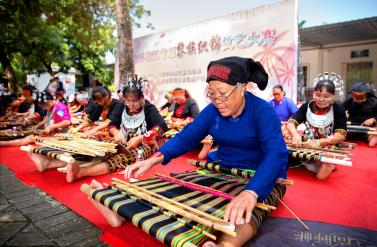

八、黎族传统纺染织绣技艺
Traditional Li Textile Techniques of Spinning, Dyeing, Weaving and Embroidering
黎族传统纺染织绣技艺,主要流传于海南岛中南部黎族聚居区,已有约3000年历史,是中国乃至世界上最古老的棉纺技艺之一。2009年入选联合国教科文组织“急需保护的非物质文化遗产”名录。
The traditional Li textile techniques are a combination of spinning, dyeing, weaving and embroidering. It is mainly practiced throughout the gathering places of the Li ethnic group in the center and south of Hainan Island. These techniques have a history of about 3,000 years, making them one of the oldest cotton textile techniques in China and even in the world. In 2009, it was inscribed on the UNESCO’s List of Intangible Cultural Heritage in Need of Urgent Safeguarding.
黎族纺织所用的原料主要有植物麻、木棉和吉贝棉(海岛棉)。其制作过程分为四道工序,即纺、染、织、绣。纺是指纺纱,染是指将纱线染成多种颜色,织是指将已染色的纱线织成布料,绣是指在已加工好的织物上用针刺绣出各种彩色花纹图案。
The main raw materials used in Li textile are hemp, kapok and Jibei cotton (island cotton). Its production is divided into our processes, namely, spinning, dyeing, weaving and embroidering. The technique of spinning is used for yarn manufacture; dyeing is to dye yarns into various colors; weaving is to weave the dyed yarns into cloth; and embroidering technique is used to embroider a variety of colorful patterns with needles on the finished fabric.
黎族的纺织品主要有黎锦和服饰等,图案多样,内涵丰富,工艺精细。其中的龙被最为驰名,工艺难度最大,文化品位最高,是古代崖州进贡朝廷的珍品。宋末元初,黄道婆将崖州棉纺织技艺传播到松江地区,对发展中国的棉纺织业做出重大贡献。
The main textiles of the Li ethnic group are Li brocade (Lijin) and Li costume, featuring various patterns, rich cultural connotations, and exquisite craftsmanship. Among them, the dragon quilt (quilt with a dragon pattern) is the most famous, with the most sophisticated craftsmanship, and highest cultural grade. It was a treasure used by the local government of ancient Yazhou to pay tribute to the imperial court. At the end of the Song Dynasty and the beginning of the Yuan Dynasty, Huang Daopo spread Yazhou’s cotton textile techniques to the Songjiang area, making a major contribution to the development of China’s cotton textile industry.
黎族纺染织绣技艺一直延续至今,为研究中国棉纺史提供了宝贵的资料,被誉为中国纺织史上的“活化石”。
The traditional Li textile techniques have continued to this day, which provides valuable materials for the study of China’s cotton textile history, and so is seen as a “living fossil” in Chinese textile history.
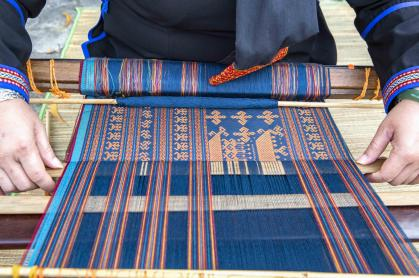
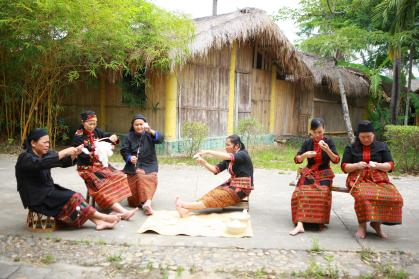
九、龙被
Dragon Quilt
龙被也称崖州被,有些地方叫做大被。龙被是黎族织锦中的珍品,是黎族纺、织、染、绣四大工艺中难度大、文化品位高、技术高超的织锦工艺品,是黎族“贡品”之一。
The dragon quilt is also known as the Yazhou quilt, and also called the great quilt in some areas. As a treasure in the Li brocade, it is a brocade artifact representing the highest achievements of the four traditional Li textile techniques of dyeing, weaving and embroidering, due to the sophisticated craftsmanship, high cultural grade and superb technology, which also made it a “tribute” that Li people paid to the royal government.
十、黎族藤(竹)编技艺
Rattan (Bamboo) Weaving Technique of the Li Ethnic Group
远在唐代,三亚黎族人民就已经熟练掌握了藤器编织技艺,工艺已达到很高水平。从唐代以来的一千多年漫长岁月中,藤器物品广泛应用于人们的日常生活,还作为贡品被历代封建朝廷征收。
As far back as the Tang Dynasty, the Li people in Sanya had already mastered the rattan weaving technique, which had reached a very high level. In the long years since the Tang Dynasty, rattan wares have been widely used in the Li people’s daily life, and were also collected by the governments in feudal dynasties as tributes.
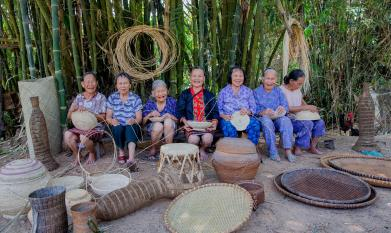
一千多年来,三亚黎族藤器编织技艺在社会生活中发挥了重要作用。这项技艺承载着黎族藤器编织史,反映黎族历史、社会的发展变迁。
For more than a thousand years, the rattan weaving technique has played an important role in social life of the Li ethnic group in Sanya. It carries the rattan weaving history of the Li ethnic group, witnessing the historical and social development and changes of the Li ethnic group.
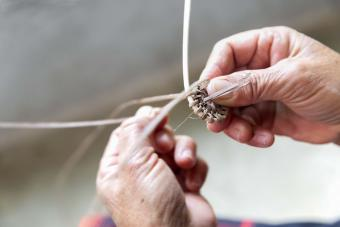
黎族人民仅凭简单的工具和手工制作,编织出紧密、坚实、美观、精致、经久耐用的多种类型物品,这些物品集中体现了其工艺价值、实用价值和科学价值。
Li people use simple tools and handwork to weave various types of artifacts that are compact, solid, artistic, delicate and durable, which embody technological value, practical value and scientific value.
